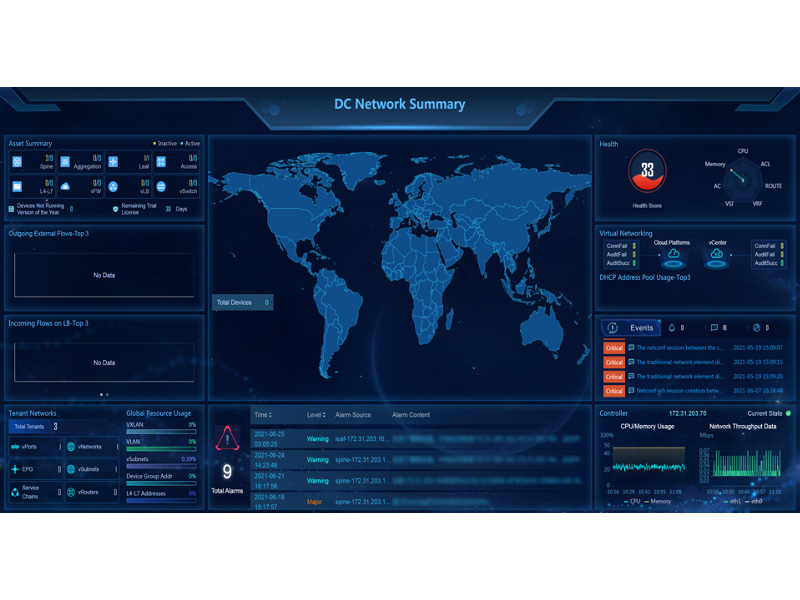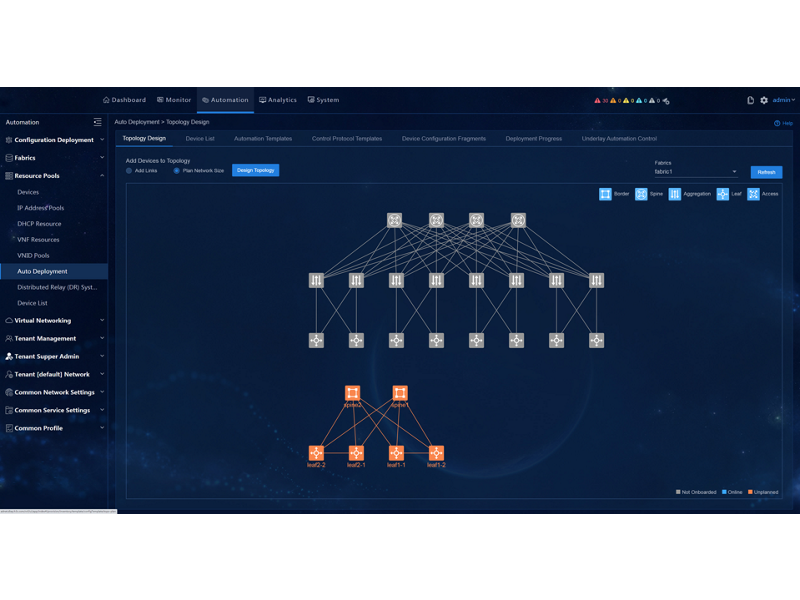The HPE IMC Orchestrator and Analyzer is an IMC solution that is designed to simplify network operations and management through orchestration, automation, and analytical capabilities. It is best suited for environments that are required to scale rapidly due to exponentially growing traffic from cloud, mobile, big data applications, and IoT .
The HPE IMC Orchestrator and Analyzer accelerates service delivery and enhances operational efficiency through its automated deployment capabilities for underlay and overlay network, service provisioning for VXLAN L2/L3 services, multi-tenant provisioning, and application performance insights with application telemetry. It also provides analytics and AI capabilities to offer a holistic view of network health for faster troubleshooting and issue resolution.
What's new
- Unified, closed-loop orchestration solution that includes network architecture design, simulation, deployment, and operations.
- Automated, role-based deployment for underlay and overlay network fabric and automated service provisioning for VXLAN L2/L3 services.
- Support for standard protocols, open interfaces, and extensible programmability for easy integration with third-party or cloud-based management platforms.
- AI-enabled network health monitoring with telemetry and visual dashboards that allow accurate fault detection, risk prediction, and analysis for faster issue resolution.
- Advanced data collection capabilities that offer visibility into application performance and user experience for near real-time network optimization, enabling seamless end-user experience and uptime.
Features
Automated Deployment and Service Provisioning
HPE IMC Orchestrator and Analyzer provides a unified, closed-loop orchestration solution that encompasses network design, simulation, deployment, and operations to enhance operational efficiency.
Supports automated, role-based deployment of underlay and overlay network fabric to enable rapid expansion of the network.
Accelerated service delivery and increased scalability are provided through automated service provisioning for VXLAN L2/L3 services.
Multi-tenant provisioning and better resource management using multiple HPE IMC Orchestrator and Analyzer instances to deploy Ethernet Virtual Interconnect (EVI) with VXLAN and MP-BGP EVPN.
Extensive Programmability and Flexibility
HPE IMC Orchestrator and Analyzer supports an extensive set of standard protocols including EVPN, VXLAN, OVSDB, NETCONF, gRPC, and ERSPAN, making it easy for customers to integrate with third-party network management and cloud platforms for unified management.
Use of northbound RESTful APIs and standard southbound interfaces including OpenFlow, NETCONF and OVSDB enable a high degree of programmability and flexibility.
Offers a great degree of openness and control plane independence at the switch level that allows administrators the flexibility to customize network operations based on business requirements.
Supports automated provisioning of a variety of compute resources such as virtual, bare metal, and containers with the help of integrations like OpenStack®.
AI-based Network Management
HPE IMC Orchestrator and Analyzer supports application telemetry with technologies such as gRPC and ERSPAN for precise data capture to the frequency of milliseconds. Distributed computing engines help achieve online and offline data analysis.
Leverages AI and machine-learning algorithms for near real-time fault detection, risk prediction, and trend analysis to significantly improve the troubleshooting experience and issue resolution time.
Provides a visual network representation of underlay and overlay topologies with correlation to offer a holistic view to network administrators for faster issue identification.
Delivers insights into application performance and provides application traffic visualization to monitor and enhance end-user experience and uptime.
Enhanced Security
HPE IMC Orchestrator and Analyzer provides on-demand security resource scheduling. Security policies can be dynamically established to meet business security requirements.
Flexible service chaining and micro segmentation offer enhanced security control and better utilization of network resources.
- OpenStack® is a trademark and/or registered trademark of the OpenStack Foundation in the United States and other countries.

